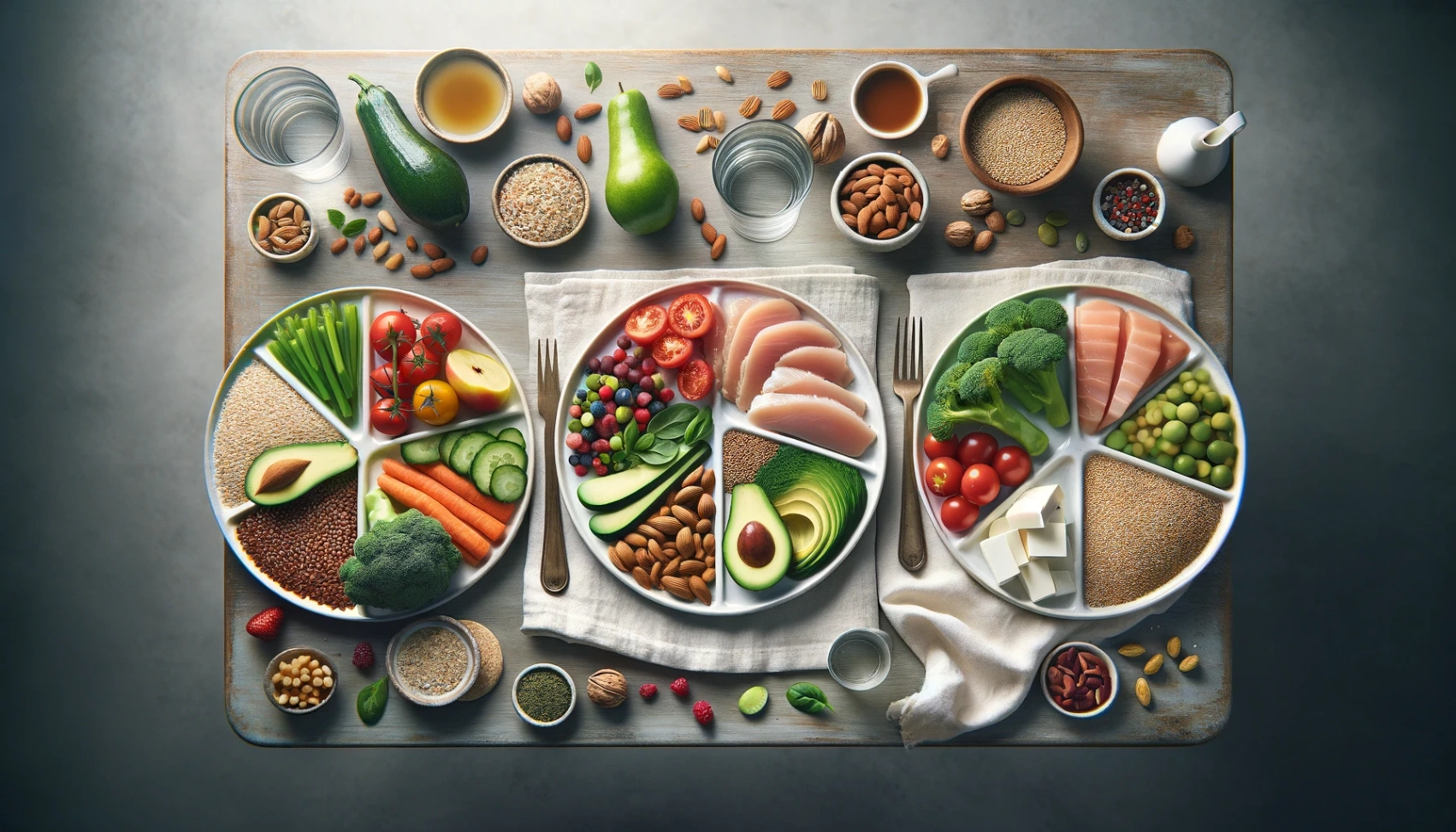Mastering the art of balanced eating is key to pursuing a healthy lifestyle. Yet, achieving nutritional harmony need not be dull or restrictive.
Discover practical strategies to enrich your diet with nourishment and flavor in this guide, ensuring each bite delivers culinary satisfaction.
Understanding a Balanced Diet
A balanced diet involves consuming various foods in appropriate proportions to meet the body’s essential nutrient needs.
It promotes overall health and reduces the risk of chronic diseases.

Key Components of a Balanced Diet
A balanced diet emphasizes incorporating key components that provide essential nutrients for optimal health.
Below are the fundamental elements necessary for maintaining nutritional equilibrium:
- Protein: Vital for tissue repair and growth, found in sources like meat, fish, eggs, and legumes.
- Carbohydrates: The body’s primary energy source, found in foods like grains, fruits, and vegetables.
- Fats: Essential for hormone production and cell function, found in sources like nuts, oils, and fatty fish.
- Vitamins: Critical for various bodily functions, obtained from a diverse range of fruits, vegetables, and fortified foods.
- Minerals: Necessary for maintaining bodily processes, sourced from foods like leafy greens, nuts, and seeds.
- Fiber: Supports digestion and promotes satiety, abundant in whole grains, fruits, and vegetables.
Importance of Variety and Moderation in Food Choices
Embracing variety and moderation in food choices is crucial for a balanced diet and overall health. Here’s why:
- Nutritional Adequacy: Variety ensures you get essential nutrients for health.
- Prevention of Deficiencies: Diversity reduces the risk of nutrient gaps.
- Enhanced Meal Enjoyment: Diverse flavors make eating more satisfying.
- Adherence to Guidelines: Moderation allows flexibility in the diet.
- Weight Management: Moderation prevents overeating and aids weight control.
Hacks for a Balanced Diet
Elevate your dietary habits with these practical hacks designed to promote a balanced and enjoyable eating experience:
1. Incorporating a Variety of Colorful Fruits and Vegetables
Add flavor, nutrients, and vibrancy to your plate with these creative strategies for incorporating more fruits and vegetables into your meals.
- Blend fruits into smoothies for a refreshing and nutritious breakfast or snack option.
- Mix vegetables into sauces, soups, or stews to increase their volume and boost nutritional content.
- Experiment with spiralized vegetables as a healthy alternative to pasta or noodles.
- Add fruits or vegetables to sandwiches, wraps, or salads for added texture and taste.
- Grill or roast vegetables to enhance their natural sweetness and flavor profile.
2. Choosing Lean Protein Sources
Protein is essential for muscle repair, immune function, and overall health. Here are some lean protein options to help meet your dietary needs:
- Skinless poultry like chicken or turkey breast
- Fish such as salmon, tuna, or cod
- Legumes like lentils, chickpeas, or black beans
- Tofu or tempeh for plant-based protein
- Low-fat dairy products like Greek yogurt or cottage cheese
3. Incorporating Whole Grains
Whole grains offer essential nutrients, fiber, and sustained energy. Here are some tips to incorporate them into your meals:
- Swap refined grains for whole grain options like brown rice, quinoa, or whole wheat pasta.
- Start your day with whole grain cereals or oatmeal for a nutritious breakfast.
- Use whole grain bread or wraps for sandwiches and wraps.
- Add barley, farro, or bulgur to soups, salads, or stir-fries for added texture and nutrients.
- Experiment with whole-grain flour in baking recipes for healthier treats.

4. Healthy Fats: Friend or Foe?
Fats play a crucial role in hormone production and cell function. Here are some tips for choosing healthier fat sources:
- Opt for unsaturated fats in foods like avocados, nuts, seeds, and olive oil.
- Include fatty fish such as salmon, mackerel, or trout, rich in omega-3 fatty acids.
- Limit saturated fats from sources like red meat, butter, and full-fat dairy products.
- Read food labels and choose products with lower trans fats or hydrogenated oils.
- Use cooking methods like baking, grilling, or steaming instead of frying to reduce added fats.
5. Mindful Eating Habits
Mindful eating fosters a deeper connection with food, promoting better digestion and appreciation of flavors.
Here are strategies to incorporate mindful eating into your routine:
- Eat slowly and savor each bite, paying attention to taste, texture, and sensations.
- Minimize distractions such as TV or phone usage during meals to focus on the eating experience.
- Listen to hunger and fullness cues, stopping when satisfied rather than overly full.
- Chew food thoroughly and take breaks between bites for better digestion and enjoyment.
- Practice gratitude for the nourishment and pleasure food provides, fostering a positive relationship with eating.
Exciting Your Taste Buds
Elevating your culinary experience involves tantalizing your taste buds with exciting flavors and textures. Here’s how to make every meal an adventure:
Exploring New Flavors and Cuisines
Expand your culinary repertoire by trying new foods and recipes from diverse cultures.
Here are some suggestions to help you explore international cuisine:
- Attend cultural food festivals or events in your area to sample authentic dishes from various regions.
- Explore ethnic grocery stores and markets to discover unique ingredients and cooking techniques used in different cuisines.
- Join cooking classes or workshops on international cuisine to learn how to prepare traditional dishes under expert guidance.
- Follow food bloggers, chefs, or cooking channels specializing in global cuisine for inspiration and recipe ideas.
- Host themed dinner parties where each guest prepares and shares a dish from a different culture, fostering a multicultural dining experience.
Experimenting with Herbs and Spices
Harness the flavor-enhancing benefits of herbs and spices to elevate your meals with aromatic richness and depth.
Here are some suggestions for incorporating them into your cooking:
- Use fresh herbs like basil, cilantro, or mint as garnishes or in marinades to add brightness and freshness to dishes.
- Experiment with dried spices such as cumin, paprika, or cinnamon to impart depth and complexity to savory and sweet recipes.
- Create homemade spice blends or rubs by combining different herbs and spices to customize flavors according to your taste preferences.
- Infuse oils or vinegar with herbs and spices to impart a subtle flavor to dressings, marinades, or dipping sauces.
- Garnish dishes with citrus zest or grated ginger for freshness and aroma, enhancing the overall flavor profile.

Cooking Techniques for Flavor
Unlock the full potential of your ingredients by mastering cooking methods that enhance flavor, texture, and aroma.
Here’s an overview of techniques to elevate the taste of your dishes:
- Grilling: Infuse meats, vegetables, and even fruits with smoky char and caramelization for a rich, savory flavor.
- Roasting: Develop deep, complex flavors by cooking ingredients at high heat, resulting in tender, caramelized exteriors and juicy interiors.
- Sautéing: Quickly cook ingredients in a small amount of oil over high heat to intensify flavors and create delicious pan sauces.
- Braising: Slowly simmer ingredients in flavorful liquids to tenderize tough cuts of meat and infuse them with a robust taste.
- Steaming: Preserve ingredients’ natural flavors and nutrients by gently cooking them in steam, resulting in light, delicate dishes.
Tips for Mastering These Cooking Techniques
Refine your culinary skills by mastering essential cooking techniques that elevate the taste and texture of your dishes.
Here are some tips to help you become proficient in these methods:
- Preheat the grill thoroughly and oil grates to prevent sticking and achieve grill marks.
- Arrange ingredients in a single layer when roasting and rotate halfway through for even browning.
- Use high heat for sautéing and avoid overcrowding the pan for proper searing and rich flavor.
- Choose meat cuts carefully for braising and use flavorful liquids like broth or wine.
- Mind cooking times when steaming to preserve natural flavors and textures.
The Bottomline
Incorporating the hacks this guide outlines promises a journey towards better health and a flavorful culinary experience.
Embrace variety, moderation, and mindful eating to transform meals into nourishing delights.
This fosters a harmonious relationship with food for lifelong wellness, satisfying taste buds, and nutritional needs.











